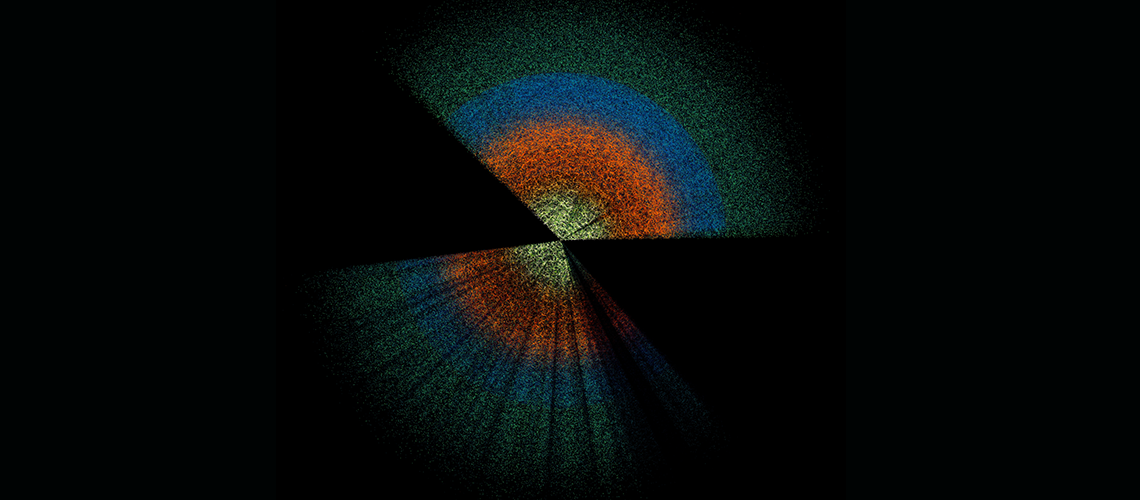Dark matter obeys gravity after all — could that rule out a 5th fundamental force in the universe?
论文
论文标题:Comparing the motion of dark matter and standard model particles on cosmological scales
作者:Nastassia Grimm, Camille Bonvin, Isaac Tutusaus
期刊:Nature Communications
发表时间:2025/11/03
数字识别码:10.1038/s41467-025-65100-8
摘要:Since dark matter particles have never been directly detected, we do not know how they move, and in particular we do not
摘要翻译(由计算机程序完成,仅供参考,内容以英文原文为准):
由于暗物质粒子从未被直接探测到,我们无从知晓其运动方式,尤其不清楚它们在引力势阱中的下落行为。传统假设认为暗物质仅通过引力与自身及标准模型粒子相互作用,因此其运动遵循欧拉方程。本文通过将星系速度测量与编码在韦尔势中的引力势阱测量相结合,首次
所属学科:
天文学
宇宙学
本篇中文由机器翻译自动生成,仅供参考,内容以英文原文为准
 DESI 合作项目观测到的星系分布图,据此可精确测量星系速度。
DESI 合作项目观测到的星系分布图,据此可精确测量星系速度。
图片来源:laire Lamman/DESI collaboration; custom colormap package by cmastro
暗物质是否遵循与普通物质相同的规律?这种构成宇宙的不可见且假想成分——既不发光也不反光——的谜团至今未解。瑞士日内瓦大学(UNIGE)等机构组成的团队试图从宇宙学尺度验证,这种物质究竟表现出普通物质的特性,还是受到其他作用力影响。发表于《自然-通讯》(Nature Communications)的研究指出二者行为相似,但也不排除存在未知相互作用的可能性。这一突破为理解这种比普通物质多五倍的神秘物质特性带来了新线索。
Does dark matter follow the same laws as ordinary matter? The mystery of this invisible and hypothetical component of our Universe — which neither emits nor reflects light — remains unsolved. A team involving members from the University of Geneva(UNIGE)set out to determine whether, on a cosmological scale, this matter behaves like ordinary matter or whether other forces come into play. Their findings, published in Nature Communications, suggest a similar behaviour, while leaving open the possibility of an as-yet-unknown interaction. This breakthrough sheds a little more light on the properties of this elusive matter, which is five times more abundant than ordinary matter.
普通物质遵循四种已知的力:引力、电磁力,以及原子层面的强力和弱力。但暗物质呢?这种不可见且难以捉摸的物质,可能受制于相同的法则,或者被第五种尚未被发现的力所支配。
Ordinary matter obeys four well-identified forces:gravity, electromagnetism, and the strong and weak forces at the atomic level. But what about dark matter? Invisible and elusive, it could be subject to the same laws or governed by a fifth, as yet unknown force.
为解开这一谜团,由日内瓦大学领导的团队着手验证在宇宙尺度上,暗物质是否会像普通物质一样坠入引力势阱(gravitational potential well)。在巨大天体的影响下,宇宙空间会发生扭曲形成凹陷。根据广义相对论和欧拉方程等既定物理定律,行星、恒星和星系等普通物质会坠入这些引力势阱——但暗物质会如何表现呢?
To unravel this mystery, a team led by UNIGE set out to determine whether, on a cosmic scale, dark matter falls into gravitational wells in the same way as ordinary matter. Under the influence of massive celestial bodies, the space occupied by our Universe is distorted, creating wells. Ordinary matter — planets, stars and galaxies — falls into these wells according to well-established physical laws, including Einstein's theory of general relativity and Euler's equations. But what about dark matter?
“为解答这一问题,我们对比了宇宙中星系的速度与引力势阱的深度。”日内瓦大学理学院理论物理系副教授、该研究合著者Camille Bonvin解释道,“如果暗物质不受第五种力的影响,那么主要由暗物质构成的星系将仅受引力支配,像普通物质一样坠入这些势阱。反之,若第五种力作用于暗物质,它将改变星系的运动方式,使其以不同方式坠入势阱。因此,通过对比势阱深度与星系速度,我们就能验证这种力的存在。”
“To answer this question, we compared the velocities of galaxies across the Universe with the depth of gravitational wells,” explains Camille Bonvin, associate professor in the Department of Theoretical Physics at UNIGE’s Faculty of Science and co-author of the study. “If dark matter is not subject to a fifth force, then galaxies — which are mostly made of dark matter — will fall into these wells like ordinary matter, governed solely by gravity. On the other hand, if a fifth force acts on dark matter, it will influence the motion of galaxies, which would then fall into the wells differently. By comparing the depth of the wells with the galaxies’ velocities, we can therefore test for the presence of such a force.”
欧拉方程依然有效
Euler's equations still valid
研究团队将这一方法应用于当前宇宙学数据后得出结论,暗物质落入引力势阱的方式与普通物质相同,因此遵循欧拉方程。“不过在现阶段,这些结论尚未排除存在某种未知力的可能性。但倘若这种第五种力真实存在,其强度不可能超过引力的7%——否则它早该在我们的分析中显现了。”该研究第一作者、日内瓦大学理学院理论物理系前博士后研究员Nastassia Grimm表示。她近期已加入英国朴茨茅斯大学(University of Portsmouth)宇宙学与引力研究所。
Applying this approach to current cosmological data, the research team concluded that dark matter falls into gravitational wells in the same way as ordinary matter, thus obeying Euler's equations. “At this stage, however, these conclusions do not yet rule out the presence of an unknown force. But if such a fifth force exists, it cannot exceed 7% of the strength of gravity — otherwise it would already have appeared in our analyses,” says Nastassia Grimm first author of the study and former postdoctoral researcher at the Department of Theoretical Physics at UNIGE’s Faculty of Science who has recently joined the Institute of Cosmology and Gravitation at the University of Portsmouth.
这些初步成果标志着在揭示暗物质特性方面取得了重大进展。下一步的挑战将是确定是否存在第五种力支配着暗物质。“即将通过大口径全天巡视望远镜(LSST)和暗能量光谱仪(DESI)等最新实验获得的数据,将能探测到强度仅为引力2%的微弱作用力。”
These initial results mark a major step forward in characterising dark matter. The next challenge will be to determine whether a fifth force governs it. “Upcoming data from the newest experiments, such as LSST and DESI, will be sensitive to forces as weak as 2% of gravity.
因此,它们应能帮助我们更深入地了解暗物质的行为,该研究的合著者、ICE-CSIC和IEEC研究员、法国图卢兹大学(University of Toulouse)Midi-Pyrénées天文台IRAP副教授Isaac Tutusaus总结道。
They should therefore allow us to learn even more about the behaviour of dark matter, concludes Isaac Tutusaus, researcher at ICE-CSIC and IEEC and associate professor at IRAP, Midi-Pyrénées observatory, University of Toulouse, co-author of the study.
更多精彩内容,请访问“日内瓦大学”官方网站:
https://unige.ch/
本文转载自“日内瓦大学”

















